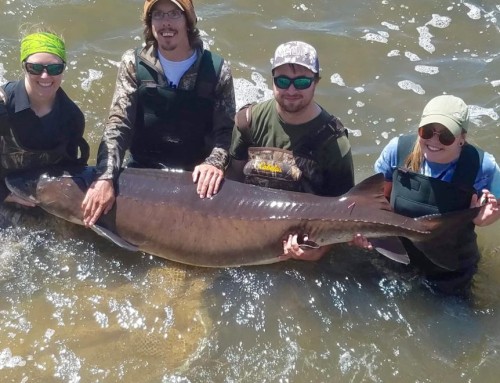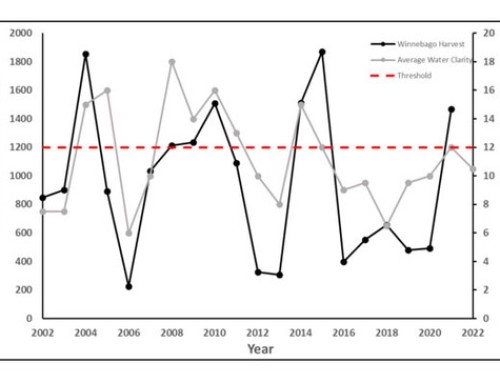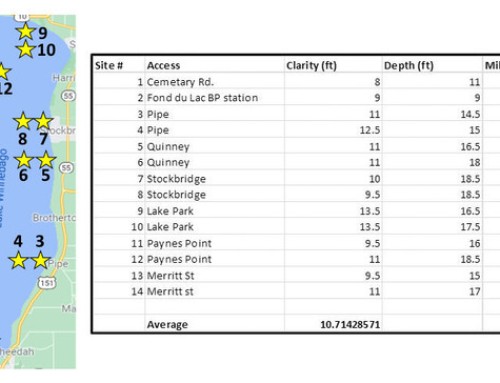Introduction and Methods:
The Winnebago System is home to one of the largest lake sturgeon populations in
North America with an estimated adult population consisting of roughly 42,500 fish.
Annual spawning migrations occur within four main rivers (Wolf, Embarrass, Little Wolf
and upper Fox), but spawning has also been periodically observed in other smaller
tributaries. There are more than 60 known spawning sites within the Winnebago System.
Most sites are “man-made” with sturgeon spawning on large riprap (12-36”) placed on
outside river bends to prevent bank erosion. The use of these spawning sites varies annually
with site use ranging from a handful to hundreds or thousands of fish.
The annual sturgeon spawning run receives extensive interest from the media and general public,
particularly at publicly accessible sites like the Sturgeon Trail (New London), Bamboo Bend (Shiocton), and SturgeonPark below the Shawano Paper Mill Dam (Shawano).
These sites provide a rare opportunity for the public to view large numbers of sturgeon spawning in
shallow water. Peak spawning typically occurs when water temperatures are 52-58 degrees Fahrenheit.
Inmost years, spawning occurs somewhere between April 10 and May 5. The average
spawning run lasts 7 days, but duration is heavily impacted by weather. Cooler
temperatures tend to result in longer spawning runs, while warm temperatures result in
more condensed runs.
Each spring, WDNR crews capture spawning lake sturgeon and collect critical
biological data that are used to assess the population and manage the winter spear harvest.
The first spawning stock assessment was conducted in 1953, with annual assessments
occurring from 1953-1964. Assessments were discontinued for roughly a decade as
biologists at the time believed they had a good understanding of the driving forces affecting
the sturgeon population and, therefore, allocated effort towards other fish species. Stock
assessments resumed in 1975 and have occurred each spring since.
Large dips nets are used to capture spawning lake sturgeon, typically with multiple dippers
working together to corral fish. Electrofishing has also been used in recent years as a gear to
capture pre-spawn lake sturgeon in the upper Fox River. All captured fish are measured to the nearest 0.1” total length (TL; measured to longest point of the caudal fin), and sex and spawning stage (green, ripe, or spent)is assigned based on extrusion of gametes (eggs or milt). Fish are then inspected for Monel (external metal tags placed on the dorsal fin) and passive integrated transponders (PIT; internal microchiptags).
Monel tags were used to mark fish for much of the 1950s through 2004, while PIT tags
have been used to mark fish since 1999. Fish were marked with both tag types from 1999-
2004, but the use of Monel tags was discontinued midway through 2004 due to poor observed
retention rates relative to PIT tags. Tag numberis documented for each recaptured fish and PIT
tags are inserted into all unmarked fish. All fish are then released back into the river. DNR
fisheries staff work the duration of the spawning run and handle as many fish as possible. A normal
spring typically consists of 1,000-2,000 fish being handled, with males comprising >80% of
the catch. Males reach sexual maturity at younger ages (males = 14-20 years; females = 20-35
years) and have a shorter spawning periodicity relative to females (males spawn every 1-2 years,
females spawn every 3-5 years).
Therefore, males heavily outnumber females in a spawning run. Males are also targeted by dippers, to some degree, as the female is what holds a group of spawning fish together. If the female is removed or spooked, then sampling efficiency decreases.
Data collected during lake sturgeon stock assessments have provided managers with a better understanding of the factors that affect population trends. Most notably, mark data
collected during spring stock assessments DNR fisheries staff use dip nets to capture a lake
sturgeon during a past stock assessment conducted on the Winnebago System.
provide the framework for estimating population abundance and exploitation (harvest)
rates. Therefore, the spawning stock assessment has historically been, and continues to be,
critical for effective management of the sturgeon population.
The primary objectives of the 2019 spawning stock assessment were to: 1) mark
fish for estimates of abundance and exploitation, 2) monitor size structure of the adult
population, 3) evaluate growth and mortality through collection of mark-recapture data, 4)
evaluate movement, and 5) determine river and spawning site fidelity of adult lake
sturgeon. In addition to these core objectives, there are several hatcheries that request
gametes (eggs and sperm) to be collected from Wolf River strain lake sturgeon as part of
their respective stocking and restoration program. The egg requests are met during the
spawning stock assessment.
Results and Discussion
Record high water levels were the primary storyline from the 2019 lake sturgeon
spawning run on the Winnebago System (Photo set 1). Lake sturgeon typically spawn in
mid to late-April. Based on 106 years of data collected by the United States Geological
Survey (USGS), median daily discharge on the Wolf River in New London are between
3,000-4,000 cubic feet per second (cfs) during this time period (Figure 1). However,
discharge during the 2019 spawning run ranged from 7,000-11,000 cfs (Figure 1; Photo set
1). The high water had a significant impact on the 2019 stock assessment as we were unable
to safely and efficiently tag fish at some of the usual locations. Many fish were also
spawning further down the rock structure in deeper water and out of the reach of our
sampling gear. Despite these challenges, WDNR crews were able to capture >1,000 fish
and meet all egg requests for various sturgeon restoration programs.
Lake sturgeon spawning commenced on April 22, 2019 and lasted through April
29. A total of 1,184 lake sturgeon (964 males and 220 females) were captured during the
spawning stock assessment (Table 1). Of the fish handled, 1,077 were captured from the
Wolf River, 102 were captured from the Embarrass River, and 5 were captured from the
upper Fox River. More fish likely would have been captured during pre-spawn
electrofishing assessments on the Upper Fox had high water levels not prohibited sampling
in the Princeton area. High water also prohibited sampling below the Manawa Dam on the
Little Wolf River.
Fish were captured at 13 different spawning locations during the 2019 adult stock
assessment. More than half of these locations (7) were located within the Wolf River, while
fish were captured at 4 sites on the Embarrass River and 2 sites on the upper Fox River
(Table 1). The Shawano Dam was the site where the most lake sturgeon were captured
(485), followed by the Sturgeon Trail (231 fish), and Bamboo Bend (163 fish) (Table 1).
These are the three largest spawning sites on the Winnebago System, so it’s no surprise
that the most fish were captured from these locations. These sites are also prioritized within
our sampling schedule and we had crews working at each of these locations for multiple
days.
Second and third spawning runs are common for lake sturgeon. These secondary
runs are typically very short, usually just 1 day, and include a small number of females.
Most females spawn during the primary run, but every year there are a few females that
ovulate a bit later in the spring. Sampling crews have periodically captured fish during
4
these secondary runs, but catch has typically been low, relative to the primary run, and
composed primarily of males. Secondary runs were observed in 2019, however, WDNR
staff did not capture any fish during these runs.
The average length of female lake sturgeon captured during the 2019 spring stock assessment was 67.3” (range 53.6- 82.8”) while the average length of
82.8”) while the average length of
males was 59.2” (range 39.7-73.2”). Females 62-74” accounted for 74.1% of the female sample,
while 71.6% of the males captured
were 54-66” (Figure 2). Lake
sturgeon that are 70 inches or
longer are normally considered
“trophy” size. Lake sturgeonexhibit se ual dimorphic growth with females reaching larger lengths than males meaning that most 70+” fish are females. Roughly 35% of the adult female lake sturgeon captured during the 2019 stock assessment were larger than 70.”
Most of the females captured during the 2019 stock assessment were assigned as
sequence 1, meaning that fish was not previously tagged (Figure 3). Sequence 5 was the
highest for any female captured during the assessment. Recaptured fish (sequences >1)
could have been captured earlier that spring, but fish were likely captured during assessments
conducted in prior years. Handling sequence data for male lake sturgeon was quite different from
females. Sequence 1 fish were still commonly observed, but only represented 40.6% of the males
sampled compared to 72.7% of females being sequence 1 capture events. There were multiple fish
with handling sequences >10, but 91.9% of fish captured were assigned to sequence 1-4. The
disparity in recapture rates between male and female lake sturgeon is attributable to the larger
number of male lake sturgeon captured during stock assessments. Males reach sexual maturity at
younger ages, have a shorter spawning periodicity, and are present on spawning grounds for a longer
time period relative to females. These reasons all contribute to the greater number of males captured
during spawning stock assessments, and the higher recapture rates of male lake sturgeon relative to
females.
The Winnebago System lake sturgeon population serves as an important brood
source for multiple lake sturgeon rehabilitation programs throughout the United States.
Despite the challenges associated with sampling in record high water levels, WDNR staff
were able to collect an adequate number of eggs to meet all stocking quotas. Gametes
collected from the Wolf River were used to meet stocking goals for restoration efforts on
Lake Michigan (streamside rearing facilities on the Milwaukee and Kewaunee Rivers) and
the Tennessee River watershed (fish stocked into Georgia, Tennessee and Kentucky). Eggs
were also collected and fertilized for the Genoa National Fish Hatchery, which is based out
of La Crosse, Wisconsin.
I would be remiss if I did not mention the volunteer support that we received during
the 2019 lake sturgeon stock assessment, particularly from the student subunit of the
American Fisheries Society at the University of Wisconsin Stevens Point. Capturing and
wrestling lake sturgeon is hard work. Over the past 8-9 years the WDNR has relied more
and more on student volunteers to assist with this assessment. Typically, there will be 5-10
students assisting WDNR crews during each weekday of the spawning run and it’s not
uncommon to have >15 students available to help on weekend days. This dedicated student
volunteer force allows WDNR staff to split into more sampling crews and maximize tagging
efforts during what is typically a condensed spawning window. Sturgeon for Tomorrow
generously supports the student subunit each year to offset travel costs of the students traveling to
and from work locations. I’ve included some photos of students “getting their hands dirty” within
this report. Thank you to everyone that volunteered during the 2019 stock assessment and I honestly can’t thank you enough for your help.
Data collected during the spawning stock assessments are critical for proper management of
the Winnebago System lake sturgeon population and spear fishery. Marking sturgeon of known sex during spring spawning stock assessments is required to derive abundance estimates that are used to
establish safe harvest limits for Students volunteers from the University of Wisconsin
Stevens Point assist DNR crews during the 2019 lake sturgeon stock assessment on the Winnebago System.
the winter spear fishery. We are fortunate that this assessment, along with all other sturgeon
related management activities, is funded by revenue generated from the sale of sturgeon
spearing licenses. Thank you to everyone that purchases a license and contributes to the
Winnebago System lake sturgeon assessment program.
The sturgeon spawning run on the Winnebago System is truly a unique event. I
strongly suggest making plans to check it out if you have never witnessed it. Predicting
exactly when spawning will take place at various locations can be near impossible. Fish
typically only spawn at a given site for 2-3 days and those dates change from year to year
depending on weather conditions. Therefore, it’s important to be flexible with travel plans
and act quickly once hearing that the spawning run is underway. More information about
the sturgeon spawning run on the Winnebago System is available through the following
link.
https://dnr.wi.gov/topic/fishing/sturgeon/sturgeonspawning.html
Ryan Koenigs
Ryan Koenigs
Winnebago Sturgeon Biologist





